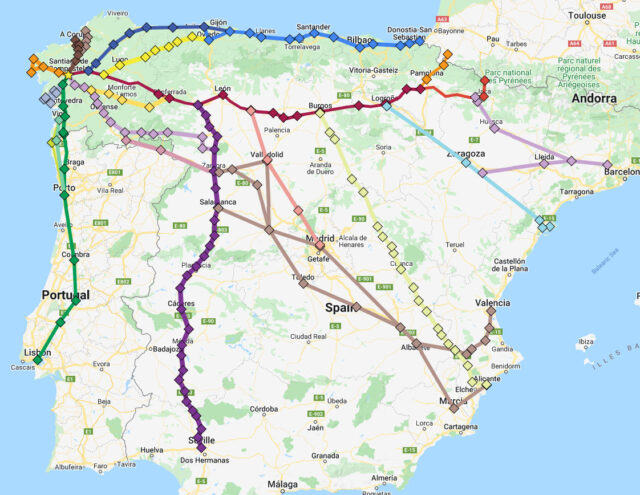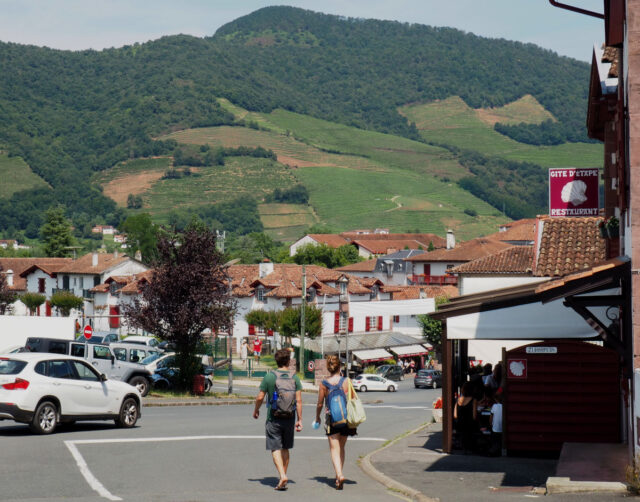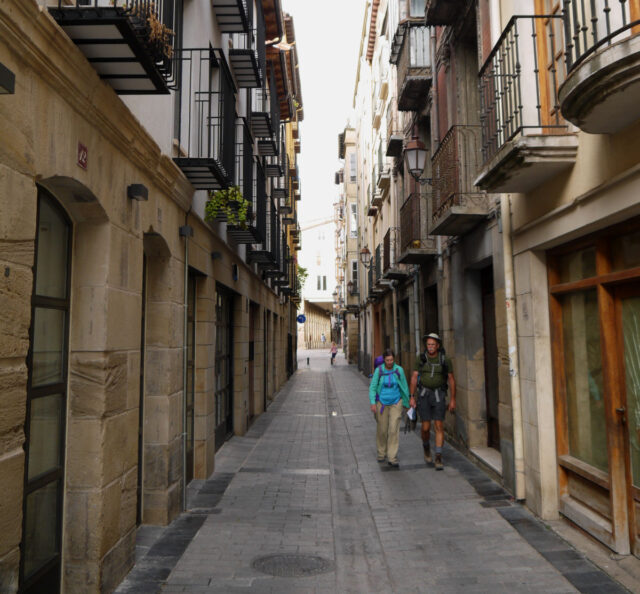During our travels in Central and Southern Europe, I have been surprised to find out how popular activity hiking along the ancient pilgrim routes in France, Spain and Portugal is. The pilgrim destination is Santiago de Compostela in northwest Spain, but routes start from France and Portugal as well. Here are 10 popular routes for hiking a famous camino (Spanish word for road, track or way).
The most popular route starts from the French side of the Pyrenees Mountains near the town of Saint-Jean Pied-de-Port. Also known as the French Way, the major milestones along this 764 km camino are:
- Saint Jean Pied de Port
- Roncesvalles
- Pamplona
- Puente la Reina
- Logroño
- Santo Domingo de la Calzada
- Burgos
- Castrojeriz
- Frómista
- Carrión de los Condes
- Ponferrada
- Sahagún
- León
- Astorga
- Villafranca del Bierzo
- Santiago de Compostela
Three routes begin from Portugal: the longest one from Lisbon, and shorter ones from Porto. Another coastal route starts from San Sebastian (Hendaya, to be exact). The Primitive Route starts from Oviedo and travels via Lugo to Santiago. Another relatively short camino, The Winter Way, goes from Ponferrada to Santiago. A long route from deep south Sevilla dwindles through sparsely populated Extremadura Province. Other long routes lead pilgrims from the Mediterranean coast, like the city of Valencia, to the French Way and further to the destination. View all 10 popular Santiago de Compostela pilgrim routes in a Google map created by Guia del Ocio.
The route that starts from Saint-Jean Pied-de-Port is three times more popular than the second popular route that starts from Portugal. The third is the relatively short English Way that starts from the city of A Coruna, north of Santiago de Compostela.
Other statistics collected by the pilgrim office indicate that in 2019, the number of certified pilgrims who completed one of the caminos was 347,598. Obviously, during the pandemic restrictions the numbers dropped considerably, but hikers are now returning to the tracks. Practically all pilgrims walk their camino, only 6% had a bicycle to speed up the journey. 30-60 years old were the largest age group (58.2%), under 30 years the second (26%), and over 60 years old the third age group (15.8%).
During our journeys in Spain I have encountered plenty of hikers trotting along their camino, but two encounters stand out. In the coastal town Zarautz in the Basque Country three hikers with large backpacks had a roadside break when we walked by. They were from the Netherlands and looked fresh, happy, and full of energy. We chatted for a moment, and I learned they had started two days ago. Happy trails. Another memorable moment took place in Logrono, the capital of La Rioja wine region. The town center is a beautiful ancient district with bars, restaurants and small low cost hotels. The scallop shell pilgrim sign was a common sight on the alleys and building walls of the old town. During the late afternoon and early evening pilgrims appeared. Most of them walked slowly, visibly tired, looking for a place to stay the night. A chat with a curious stranger wasn’t an activity they were looking for. Man, I thought, how do they make it to Santiago?
They do. Many hikers reach the destination, and they have a certification to prove it. Oficina del Peregrino is the official organization that register pilgrims before the journey starts, stamps the document in designated milestones and in the end, hands out the certificate. At the time of writing this in early May, the office certified 1033 pilgrims in Santiago during one day.
The best seasons to hike the pilgrim distance
In Spain, summers are very warm and even warmer the further south you go. The best season to hike is spring and autumn. Winter tends to be rainy in the north and cold on mountains and on inland plateaus. The meteorological institute of Spain has handy maps that show the rainy regions and warm regions for each month.
If you absolutely have to hike in July and August (June and September are often very warm as well), the coastal routes have refreshing winds and showers from the Atlantic Ocean to keep temperatures more acceptable for physical activity like hiking. The routes that start from Portugal (for instance, 624 km from Lisbon) and follow the coastline are an option, as well as the Northern Way (824 km) that begins from San Sebastian, and follows the northern coast of Spain.
In addition to the best season, you might be pondering what is the most scenic route. The coastal routes are a good choice for those who like sea views and humidity of the sea. The northwest coast of Spain is lush green through the year. The inland routes in Spain can be hilly, mountainous, or plains in low or high altitude. A little bit of research is required to find a desired landscape. I can tell which routes are the most boring ones that even car drivers dislike. There is a vast, windy plain that stretches from southeast Spain to Madrid, roughly between Albacete and the capital.



